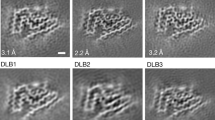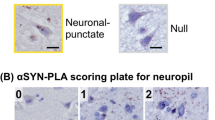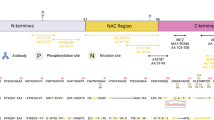Abstract
Lewy bodies (LBs) of idiopathic Parkinson’s disease and glial cytoplasmic inclusions (GCIs) of multiple system atrophy are pathological deposits both composed of phosphorylated α-synuclein woven into different filaments. Although both LBs and GCIs are considered to be hallmarks for each independent synucleinopathy, until now they could not be clearly distinguished on the basis of their biochemical or immunohistochemical features. We have examined possible differences in their argyrophilic features and their relation to synuclein-like or ubiquitin-like immunoreactivity (IR). Pairs of mirror sections from different brain areas were triple-fluorolabeled with an anti-α-synuclein antibody, an anti-ubiquitin antibody and thiazin red (TR), a fluorochrome that labels fibrillary structures such as Lewy bodies or neurofibrillary tangles. One of the paired sections was subsequently stained using the Campbell-Switzer method (CS), and the other by the Gallyas-Braak method (GB). By comparing of the same microscopic field on the paired fluorolabeled sections, subsequently silver-stained with either CS or GB, five different profiles of each structure could be determined: α-synuclein-like IR, ubiquitin-like IR, affinity to TR, argyrophilia with CS or GB. GCIs exhibited argyrophilia with both CS and GB but lacked affinity to TR. In contrast, LBs exhibited argyrophilia with CS but not with GB and some affinity to TR. These disease-specific profiles of argyrophilia were consistent, and were not influenced by areas or cases examined. Although immunohistochemical features of LBs and GCIs were similar in exhibiting IR for α-synuclein and ubiquitin, the contrast in their argyrophilic profiles may indicate possible differences in the molecular composition or conformation of α-synuclein. Even though these empirical differences still remain to be explained, awareness of this clear distinction is potentially of diagnostic and pathological relevance.
Similar content being viewed by others
Avoid common mistakes on your manuscript.
Introduction
Lewy bodies (LBs) of Parkinson’s disease (PD) and glial cytoplasmic inclusions (GCIs) of multiple system atrophy (MSA) are pathological deposits containing phosphorylated α-synuclein as one of their major constituents [5]. These diseases are grouped under the name “synucleinopathies” based on the assumption that LBs and GCIs share common mechanism for α-synuclein deposition [7]. Indeed, biochemical and immunohistochemical features of these deposits look so alike that a clear distinction between the two types of deposits using these methods is still difficult.
Another method to identify these deposits is silver staining [2, 15]. Our previous studies on argyrophilic features of sporadic degenerative tauopathies demonstrated that silver staining profiles are closely related to tau deposits in a disease- or isoform-specific fashion. Deposits containing mainly three-repeat (3R) tau, such as Pick bodies [23], are labeled by Campbell-Switzer silver staining method (CS) [4, 16]. In contrast, those containing mainly four-repeat (4R) tau, as seen in corticobasal degeneration (CBD)/progressive supranuclear palsy (PSP) [21] and argyrophilic grains [22], are silver-stained using the Gallyas-Braak method (GB) [3, 6]. Neurofibrillary tangles of Alzheimer type, containing both 3R and 4R tau, are stained with both CS and GB [21, 22, 23]. These findings led us to conclude that 3R tau deposits are related to CS and 4R tau deposits to GB. It means that each method of silver staining exhibits argyrophilia in different ways and potentially represents underlying molecular or “qualitative” differences.
Expecting that similar qualitative differences, distinguishable with silver staining, may be present among α-synuclein-positive deposits, we were prompted to examine their argyrophilic profiles with CS and GB. This is the first study demonstrating disease-specific profiles of argyrophilia in synucleinopathies.
Materials and methods
Six cases of MSA and five cases of PD were enrolled into this study. Demographic data on these cases are shown in Table 1. Clinical diagnosis of PD was based on levodopa-responsive parkinsonism with tremor, rigidity, and bradykinesia, and was confirmed pathologically in all the cases by the presence of LBs and neuronal depletion in the substantia nigra, locus ceruleus and dorsal motor nucleus of vagus. Clinical diagnosis of MSA was differentiated from PD by concomitant ataxia (with cerebellar atrophy demonstrated by brain imaging), marked pyramidal signs and profound autonomic dysfunction. Pathological confirmation of MSA was based on the degeneration in the putamen, substantia nigra, pons, inferior olive and cerebellum and the presence of GCIs [12, 13].
Brains were fixed in formalin and embedded in paraffin. Areas rich in α-synuclein-positive deposits (motor cortex, putamen, pontine nucleus and cerebellum for MSA; limbic cortex, nucleus basalis of Meynert, amygdala, midbrain and medulla oblongata for PD) were examined for their argyrophilia with GB and CS on adjacent sections.
In addition, mirror section pairs (4 µm thick) from these areas were subjected to subsequent studies to identify possible relation between α-synuclein-like immunoreactivity (IR), ubiquitin-like IR and argyrophilia. Pairs of mirror sections were autoclaved and incubated at 4°C for 2 days with a mixture of an anti-synuclein mouse monoclonal antibody (1:200, LB509; a generous gift from Prof. T Iwatsubo, University of Tokyo [11]) and an anti-ubiquitin rabbit polyclonal antibody (DAKO, Glostrup, Denmark) and the target epitopes were visualized with an anti-mouse IgG conjugated with Alexa 488 (1:200; Molecular Probes, Eugene, OR) and an anti-rabbit IgG conjugated with Alexa 647 (1:200; Molecular Probes). Sections were then incubated with thiazin red (TR; 1:30,000; Wako, Tokyo, Japan), a fluorochrome that labels fibrillary structures such as LBs [14] or NFTs [18, 19] for 15 min. After being observed under a confocal microscope (Leica TCS/SP, Heidelberg, Germany), one of the section pair was stained with GB [3, 6] and the other with CS [4, 16] to compare argyrophilic properties of each α-synuclein-, ubiquitin- or TR-positive structure. Identification of the same microscopic field on the fluorescence images (α-synuclein, ubiquitin and TR) and on the corresponding silver-stained (GB and CS) pair-wise images allowed us to compare staining profiles of each structure based on five different properties; α-synuclein IR, ubiquitin IR, affinity to TR, argyrophilia with GB and that with CS [21, 22, 23]
Results
GCIs exhibited argyrophilia with both CS (Fig. 1A, C) and GB (Fig. 1B, D) to an equivalent extent. Argyrophilia of LBs were clearly detectable with CS (Fig. 1E, G). However, LBs identified on GB-stained sections (Fig. 1F, H) were, at most, weakly argyrophilic (arrow in Fig. 1F, H). These argyrophilic features were consistent and were not influenced by the case or area examined.
:Silver-stained mirror sections (left column: with CS; right column: with GB) of MSA (A–D) and of PD (E, F). GCIs in the internal capsule are stained with CS (A, C). Those in the mirror section pair are similarly stained with GB (B, D). C, D Higher magnification of the corresponding squared area in A and B, respectively. LBs in the amygdala are stained with CS (arrow in E, G) but hardly stained with GB (arrow in F, H). Neuritic plaque is stained with CS (double arrowhead in E) and with GB (double arrowhead in F), while the diffuse plaque, stained with CS (arrowhead in E, G), is not with GB (arrowhead in F, H). Asterisk in A, B and that in E, F indicate the same blood vessels in paired mirror sections (CS Campbell-Switzer method, GB Gallyas-Braak method, MSA multiple system atrophy, PD Parkinson’s disease, GCIs glial cytoplasmic inclusions, LBs Lewy bodies). Bars A, B, E, F 100 µm; C, D, G, H 25 µm
Relation of these argyrophilic structures to α-synuclein-like IR and ubiquitin-like IR was examined on paired sections that were initially fluorolabeled and then silver stained (Fig. 2). On the triple-fluorolabeled sections from MSA patients (Fig. 2a–d), most GCIs exhibited α-synuclein-like IR (green) and ubiquitin-like IR (blue) to yield blue-green color. No affinity to TR (red) was detectable even when the detection threshold was lowered enough to give background myelin staining. Therefore, none of the GCIs appeared white with triple fluorolabeling. Subsequent silver staining of these section pairs demonstrated that GCIs exhibited argyrophilia with both CS (Fig. 2A, C) and GB (Fig. 2B, D) to a similar extent.
Triple-fluorolabeled mirror sections (a–g) stained for α-synuclein (green), TR (red) and ubiquitin (blue), subsequently silver stained with CS (A, C, E, G) or GB (B, D, F, H). GCIs in the cerebellar white matter (A, a, b, B) exhibit α-synuclein-like (green) and ubiquitin-like (blue) IRs, but the lack of affinity to TR (red), yielding a blue-green appearance in GCIs. These GCIs are silver stained with CS (A, higher magnification of the squared area in a) and GB (B, higher magnification of the squared area in b). GCIs in the putamen (C, c, d, D) exhibited similar IR and silver-staining profiles. LBs in the nucleus basalis of Meynert (E, e, f, F), are spherical and exhibit α-synuclein-like (green) and ubiquitin-like (blue) IRs and affinity to TR (red) to yield a whitish appearance (arrowhead in e, f). These LBs are stained with CS (arrowhead in E) but not with GB (arrowhead in F). LBs in the dorsal motor nucleus of vagus (arrowhead in G, g. h, H) are diverse in their morphology but their fluorescence signals (g, h) are similar to those from LBs in the nucleus basalis (e, f). Lewy neurites (arrow in G, g, h, H) share these staining profiles. These LBs (arrowhead), as well as Lewy neurites (arrow) are stained with CS (G) but not with GB (H). Asterisk in a, b, C, c, d, D, G, g, h, and H denotes the same blood vessel observed in paired mirror sections (TR thiazin red, IR immunoreactivity). Bars A, B 10 µm; otherwise 50 µm
On the triple fluorolabeling of mirror section pairs from PD (Fig. 2e–h), most LBs exhibited synuclein-like IR (green) and ubiquitin-like IR (blue) to yield blue-green color. Some of these LBs appeared white as they also exhibited affinity to TR (red, arrowhead in Fig. 2e, f). All of these LBs, including Lewy neurites, were clearly stained with CS, regardless of their location (Fig. 2E, G). However, GB hardly visualized these structures (Fig. 2F, H).
Discussion
LBs and GCIs are composed of similarly phosphorylated synuclein [5] woven into fibrils and diseases demonstrating these deposits are grouped under the title “synucleinopathies” [7] on the supposition that a common mechanism is involved in the formation of LBs and GCIs. Most of the biochemical and immunohistochemical features related to α-synuclein are shared between LBs and GCIs, and this is one of the reasons why immunohistochemical markers are not very successful in distinguishing the two different synuclein deposits. In the present study, we demonstrated that, using GB and CS, the argyrophilic properties of LBs and GCIs were distinct; i.e., GCIs exhibited argyrophilia with both CS and GB, whereas LBs were labeled by CS but not by GB. These disease-dependent argyrophilic features were consistent, and were not influenced by the case or area examined. We have previously reported that some LBs have an affinity to TR [14], a fluorochrome that labels fibrillary structures, such as NFTs [18, 17, 19]. Comparison of LBs and GCIs clarified that GCIs lacked affinity to TR. Since the differences in molecular composition between LBs and GCIs have not yet be clarified, at present we have no reasonable explanation for these empirical differences. One possibility is that a difference in the α-synuclein molecule itself, or its modification, leads to a conformational state specific to LBs or GCIs, thereby exhibiting distinct argyrophilic property, affinity to TR and ultrastructure. As we reported previously, the argyrophilic properties of tau-positive deposits are linked to its isoform; tau-positive deposits containing mainly 4R tau, as seen in CBD/PSP [21] and AGs [22], are labeled with GB but not with CS, whereas those containing mainly 3R tau, as seen in Pick bodies, exhibit argyrophilia with CS but not with GB [23]. Because deposits containing 3R and 4R tau exhibit argyrophilia with both CS and GB, it is likely that those containing 3R tau are linked to argyrophilia with CS and those containing 4R tau deposits are linked to GB. Thus, it is possible that molecules associated with α-synuclein may differ and yield different staining properties.
Although silver staining methods are useful tools in the diagnosis of neurodegenerative diseases [20], little is known regarding the mechanism of argyrophilia [8, 10]. It is interesting that the lack of argyrophilia with GB, as seen in LBs, is shared with Pick bodies [23]. Moreover, colocalization of α-synuclein and tau epitopes is frequent in various degenerative processes [1], and these two proteins may interact during the formation of aggregates [9]. It is then possible that tau and synuclein undergo similar conformational changes to be detected with CS but not with GB, as seen in Pick bodies and LBs. Even though, the empirical distinction based on these argyrophilic profiles is of help in the histological diagnosis of synucleinopathies, the mechanism responsible for these changes in vivo still need to be determined. Another advantage of these silver stainings is that they will give, at lower cost, more consistent results than immunohistochemistry, especially when dealing with old archival sections [15]. Furthermore, identities of LBs and GCIs are frequently confounded in experimental paradigms by grouping them as synuclein-positive aggregates without discriminating them. Although the molecular identities of LBs and of GCIs remain to be clarified, defining these inclusions based on various methods, such as with silver staining, is of great advantage because other biochemical or immunohistochemical features fail to discriminate these two distinct α-synuclein-positive inclusions. It is obvious that further studies are needed to identify possible differences in the molecular composition of LBs and GCIs. At present, silver staining profiles, possibly distinctive and representative of each type of inclusions, provide a unique method of classifying not only tau-related but also α-synuclein-related deposits, which may be helpful in diagnosing and understanding synucleinopathies and tauopathies.
References
Arima K, Hirai S, Sunohara N, Aoto K, Izumiyama Y, Uéda K, Ikeda K, Kawai M (1999) Cellular co-localization of phosphorylated tau- and NACP/alpha-synuclein-epitopes in Lewy bodies in sporadic Parkinson’s disease and in dementia with Lewy bodies. Brain Res 843:53–61
Braak E, Braak H (1999) Silver staining method for demonstrating Lewy bodies in Parkinson’s disease and argyrophilic oligodendrocytes in multiple system atrophy. J Neurosci Methods 87:111-115
Braak H, Braak E, Ohm TG, Bohl J (1988) Silver impregnation of Alzheimer’s neurofibrillary changes counterstained for basophilic material and lipofuscin pigment. Stain Technol 63:197–200
Campbell SK, Switzer RC, Martin TL (1987) Alzheimer’s plaques and tangles: a controlled and enhanced silver staining method. Soc Neurosci Abstr 13:67
Fujiwara H, Hasegawa M, Dohmae N, Kawashima A, Masliah E, Goldberg MS, Shen J, Takio K, Iwatsubo T (2002) alpha-Synuclein is phosphorylated in synucleinopathy lesions. Nat Cell Biol 4:160–164
Gallyas F (1971) Silver staining of Alzheimer’s neurofibrillary changes by means of physical development. Acta Morphol Acad Scient Hung 19:1–8
Galvin JE, Lee VM, Trojanowski JQ (2001) Synucleinopathies: clinical and pathological implications. Arch Neurol 58:186–190
Gambetti P, Autilio-Gambetti L, Papasozomenos SC (1981) Bodian’s silver method stains neurofilament polypeptides. Science 213:1521–1522
Giasson BI, Forman MS, Higuchi M, Golbe LI, Graves CL, Kotzbauer PT, Trojanowski JQ, Lee VM (2003) Initiation and synergistic fibrillization of tau and alpha-synuclein. Science 300:636–640
Iqbal K, Braak E, Braak H, Zaidi T, Grundke-Iqbal I (1991) A silver impregnation method for labeling both Alzheimer paired helical filaments and their polypeptides separated by sodium dodecyl sulfate-polyacrylamide gel electrophoresis. Neurobiol Aging 12:357–361
Jakes R, Crowther RA, Lee VM, Trojanowski JQ, Iwatsubo T, Goedert M (1999) Epitope mapping of LB509, a monoclonal antibody directed against human alpha-synuclein. Neurosci Lett 269:13–16
Nakazato Y, Yamazaki H, Hirato J, Ishida Y, Yamaguchi H (1990) Oligodendroglial microtubular tangles in olivopontocerebellar atrophy. J Neuropathol Exp Neurol 49:521–530
Papp MI, Kahn JE, Lantos PL (1989) Glial cytoplasmic inclusions in the CNS of patients with multiple system atrophy (striatonigral degeneration, olivopontocerebellar atrophy and Shy-Drager syndrome). J Neurol Sci 94:79–100
Sakamoto M, Uchihara T, Hayashi M, Nakamura A, Kikuchi E, Mizutani T, Mizusawa H, Hirai S (2002) Heterogeneity of nigral and cortical Lewy bodies differentiated by amplified triple-labeling for alpha-synuclein, ubiquitin, and thiazin red. Exp Neurol 177:88–94
Sandmann-Keil D, Braak H, Okochi M, Haass C, Braak E (1999) Alpha-synuclein immunoreactive Lewy bodies and Lewy neurites in Parkinson’s disease are detectable by an advanced silver-staining technique. Acta Neuropathol 98:461–464
Switzer RC III (1993) Silver staining methods: their role in detecting neurotoxicity. Ann NY Acad Sci 679:341–348
Uchihara T, Nakamura A, Yamazaki M, Mori O (2000) Tau-positive neurons in corticobasal degeneration and Alzhemer disease—Distinction by thiazin red and silver impregnation. Acta Neuropathol 100:385–389
Uchihara T, Nakamura A, Yamazaki M, Mori O (2001) Evolution from pretangle neurons to neurofibrillary tangles monitored by thiazin red combined with Gallyas method and double immunofluorescence. Acta Neuropathol 101:535–539
Uchihara T, Nakamura A, Yamazaki M, Mori O, Ikeda K, Tsuchiya K (2001) Different conformation of neuronal tau deposits distinguished by double immunofluorescence with AT8 and thiazin red combined with Gallyas method. Acta Neuropathol 102:462–466
Uchihara T, Ikeda K, Tsuchiya K (2003) Pick body disease and Pick syndrome. Neuropathology 23:318–326
Uchihara T, Shibuya K, Nakamura A, Yagishita S (2005) Silver stains distinguish tau-positive structures in corticobasal degeneration/progressive supranuclear palsy and in Alzheimer’s disease—Comparison between Gallyas and Campbell-Switzer methods. Acta Neuropathol 109:299–305
Uchihara T, Tsuchiya K, Nakamura A, Akiyama H (in press) Argyrophilic grains are not always argyrophilic-Distinction from neurofibrillary tangles of diffuse neurofibrillary tangles with calcification revealed by comparison between Gallyas and Campbell-Switzer methods-. Acta Neuropathol DOI: 10.1007/s00401-005-1031-7
Uchihara T, Tsuchiya K, Nakamura A, Akiyama H (2005) Silver staining profiles distinguish Pick bodies from neurofibrillary tangles of Alzheimer type—Comparison between Gallyas and Campbell-Switzer methods. Acta Neuropathol 109:483–489
Acknowledgements
Supported in part by the grant from the Ministry of Education, Culture, Sports, Science and Technology (grant in aid for scientific research B15300118) to T.U.
Author information
Authors and Affiliations
Corresponding author
Rights and permissions
About this article
Cite this article
Uchihara, T., Nakamura, A., Mochizuki, Y. et al. Silver stainings distinguish Lewy bodies and glial cytoplasmic inclusions: comparison between Gallyas-Braak and Campbell-Switzer methods. Acta Neuropathol 110, 255–260 (2005). https://doi.org/10.1007/s00401-005-1044-2
Received:
Revised:
Accepted:
Published:
Issue Date:
DOI: https://doi.org/10.1007/s00401-005-1044-2






